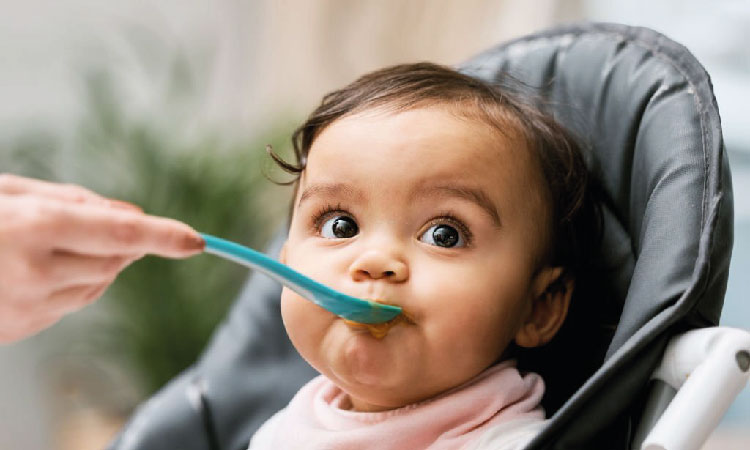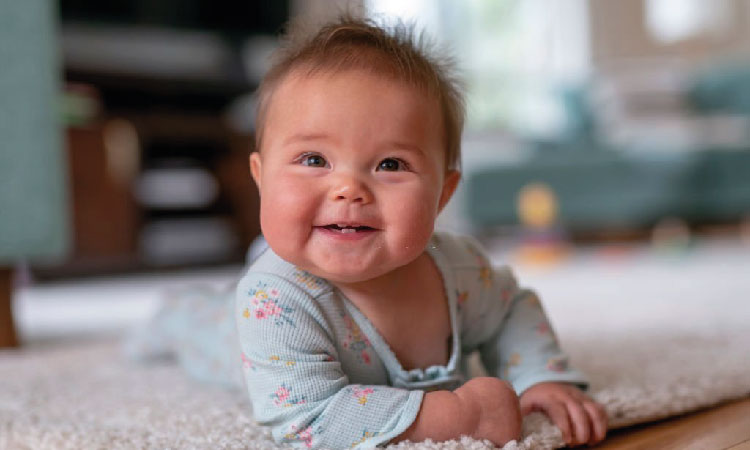Many babies and their parents experience a significant change at the three-month mark. Now that your baby has lived through the first three months of their first year, you can stop calling them a newborn. They’ve accomplished many firsts, including following moving objects with their eyes, using their hands to reach and grasp, and propping themselves up on their arms while on their bellies. Still, you may be like other parents who are curious about the major developmental milestones their 3-month-old may soon achieve. Read on to learn more about the third month’s baby milestones.
Important Development Milestones For 3 Months Old Babies
Your baby will go through a remarkable developmental leap from a helpless newborn to an alert and curious infant by the time he or she reaches the third-month mark.
- The posterior fontanelle, also known as the soft spot at the back of your baby’s head, should have closed up by the time your baby is three months old. Your child’s head may appear to be larger than their body. It’s perfectly normal; the body will eventually catch up1
- At this point, she has gained more control over her body and has lost many of the reflexes she had as a newborn
- If you hold your 3-month-old in a “standing” position with their feet on a hard surface, they will sag at the knees, which is a sign that they no longer have the “grasp” and “stepping” reflexes they once did
- They are capable of grasping a simple toy, but their hand-eye coordination is not yet fully formed
- They stare fixedly at people’s faces
- Their interest is piqued by moving objects
- A child of three months can recognize people and objects in faraway settings
- Develops the ability to control both hands and eyes simultaneously
- Because their hearing is still developing, they become overly excited at the sound of voices, footsteps, running water in the bathtub (time for some fun!), or the approach of the feeding truck
- Drooling is a common symptom of teething, which can begin as early as 3 months, so don’t be alarmed if you don’t see any teeth emerging shortly2
Related Reading: 11 Tips To Prevent Diaper Rash From Cloth Diapers
Development Milestones For 3 Months Old Baby
No two babies are alike, nor are their rates of development and intellect. Yet, there are discernible patterns in how a baby develops. This month, your child’s weight and length will rise by around 681 grams to 1,735 grams and 2.5 to 3.8 cm, respectively3
Common developmental milestones for newborns at the 3-month mark are outlined below4.
- Babies at 3 moths have a lot of energy and fluidity in their movements
- Display better head control
- They may also be beginning to sway from side to side and front to back
- They have excellent focus and can track an object moving in a semicircle about 20cm in front of them
- Your baby will be able to distinguish between objects and their backgrounds thanks to their enhanced vision
- They are also developing a more refined tactile perception
- The attention span of a baby is significantly increased around this time
- Baby is obsessed with her hands and spends a lot of time studying how they work
- Changing diapers can be difficult now that your baby can kick with both legs at once
Related Reading: 12 Fun And Learning (Activities For Babies 0-6 Months)
Feeding Milestones

Babies are now able to go longer without eating, and their feeding schedule may be more regular5
- Around this time, most infants experience a growth spurt, which often results in increased appetite. During growth spurts, babies often become more irritable and demand to be nursed as frequently as every 30 minutes6
- At three months old, babies typically consume anywhere from 720 ml to 1200 ml per day across five to eight feedings
- Formula-fed infants typically eat less frequently, about once every four hours, while breastfed infants may eat as many as eight times in a 24-hour period
Related Reading: 11 Signs Of An Underfed Baby | Your Baby Is Hungry
Sleep Milestones
The nervous system of your child who is 3 months old is maturing, and their tummy has the capacity to take in additional milk or formula. Your baby, therefore, should now be able to sleep for longer stretches.
- A child who is three months old needs anywhere from 14 to 16 hours of sleep per day, which includes approximately three or more hours of naps during the day7
- According to one source, around the age of three months, the majority of infants begin to “sleep through,” or sleep for a continuous period of five or six hours during the night.)
Related Reading: Is It Safe To Apply Kajal To Baby’s Eyes?
Speech Milestones
It’s likely that your infant is beginning to show signs of emotion and communicate with you now. The infant’s facial and bodily expressions become more varied and expressive, and the infant begins to mimic certain gestures and expressions. Also, the baby can8
- Smile when he hears your voice
- Turn toward the sound.
- Start babbling
- Start to mimic a few sounds
- They will make a lot of gurgling noises and make attempts to answer your questions or comments
Related Reading: Using Silverware For Babies -Importance, Benefits, And Precautions
Physical Milestones
Your baby is much stronger now, and when you prop up their shoulders in a sitting position, they can look around with an erect head and a straight upper back. By this time the baby9:
- Lifts head and chest when lying on their tummy
- Holds up the upper body when lying on the stomach with the arms
- Has sufficient lower body strength to stretch out and kick
- They open and close the hand
- Puts hand to his mouth
- When the feet are placed on a firm surface, there is a downward force exerted on the legs.
- Attempts to capture hanging items by slashing at them
- Grasps and wiggles rattle and other hand toys
Related Reading: 12 Home Remedies To Ease Your Baby’s Vaccination Pain
How To Keep A 3-Month-Old Baby Busy

Now, what to do with a 3-month-old baby all day? At three months, your baby will start letting you know through yawning, looking away, wriggling, and crying that they’re bored. If you notice that your infant seems bored, try distracting them with a new activity to show that you are paying attention.
- Time for stories: Now is the time for storytelling. Babies at this age are still developing their linguistic abilities, even if they are unable to speak or understand. The more you read and converse with your baby, the better. It is one of the excellent things to do with a 3-month-old inside. It will teach them the fundamentals of language and the way that dialogue is structured. To infants of this age, there is nothing more comforting than hearing their mom’s voice and being close to them
- Take a stroll: There’s nothing better than getting out in the fresh air with your baby. When it comes to things to do with a 3-month-old outside, this is a great idea. Even a short stroll can reveal surprising new sights to a baby of three months. Put them in the baby carrier or stroller, then head out to your preferred trail or park. Along the way, make your baby aware of the various things that are going on and talk to them about what you see. There is no need to worry about whether or not the baby is comprehending what you are saying.
- Play with fabrics: Babies at the three-month mark are fascinated by touch. Use your baby’s sense of touch to explore the cashmere, cotton, and silk in your wardrobe. Scrub their whole body with the materials. Even making them lie down on the textiles helps them to explore the fabric with their whole body. Anything like beads, needlework, or other decorations will also be interesting for the baby to investigate. Still, monitor them and make sure they don’t swallow anything too little
- Show and tell: Toys, board books, and plush animals are all good options. As soon as they get sight of it, explain what it is and move it from side to side so they can follow it with their eyes. It is one of the best 3-month baby activities, that will assist children in becoming better able to coordinate the motions of their heads and eyes
Related Reading: 9 Early Signs Of Intelligence In Babies
When To See A Doctor
While every baby grows and learns at her own pace, delays in reaching key developmental milestones might indicate health or other issues that need to be addressed. Talk to your physician if your baby shows any of the following symptoms at this age10.
- Doesn’t appear to react to loud noises
- Not able to support their heads
- Noticing their hands
- Issues with limbs movement
- Can’t muster a smile
- They haven’t started babbling yet.
- Baby won’t be able to keep her attention on moving targets.
- At three months old, is unable to grip and hold items.
- Baby still can’t hold its head up.
- Not trying to reach toys
Conclusion

If you’re a new parent, you can feel disheartened or jealous if you find out that another baby your child’s age has already achieved a certain developmental milestone. Nothing to fret about if your child is growing properly and meeting their milestones on time. It is crucial to follow up with the doctor if you have concerns about your infant’s physical or developmental delay.

